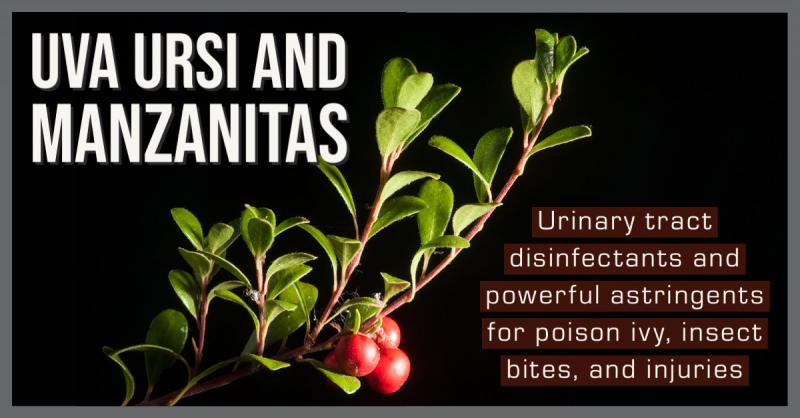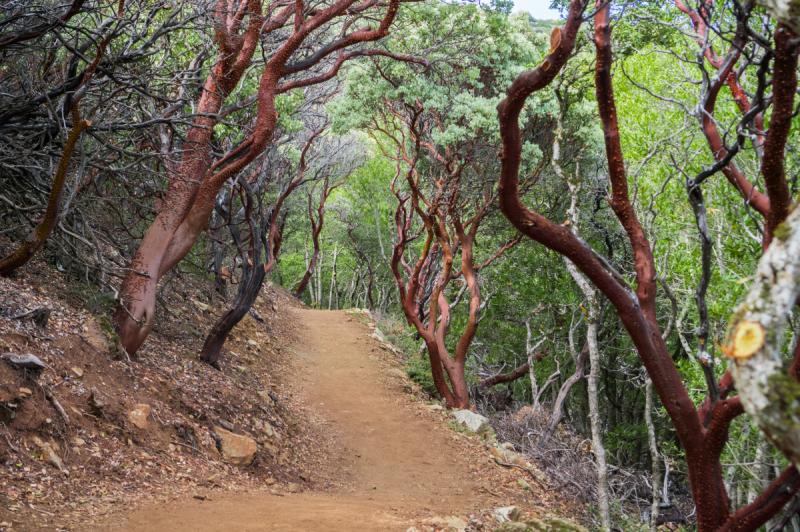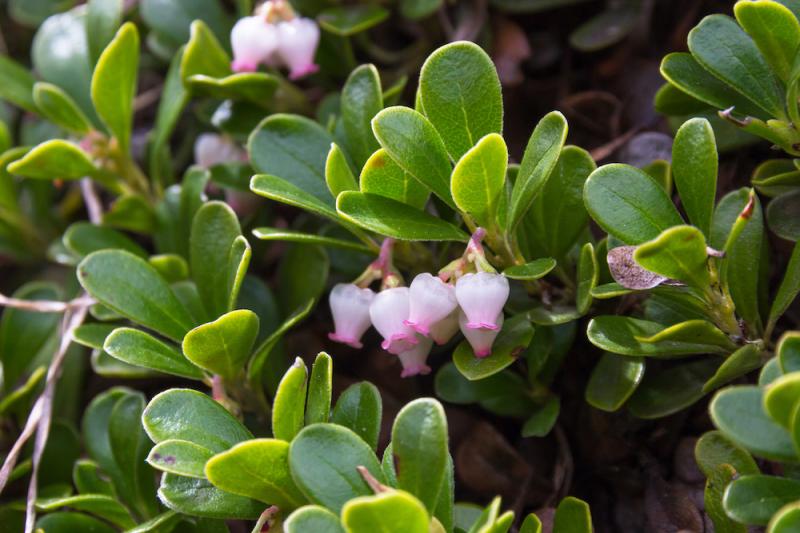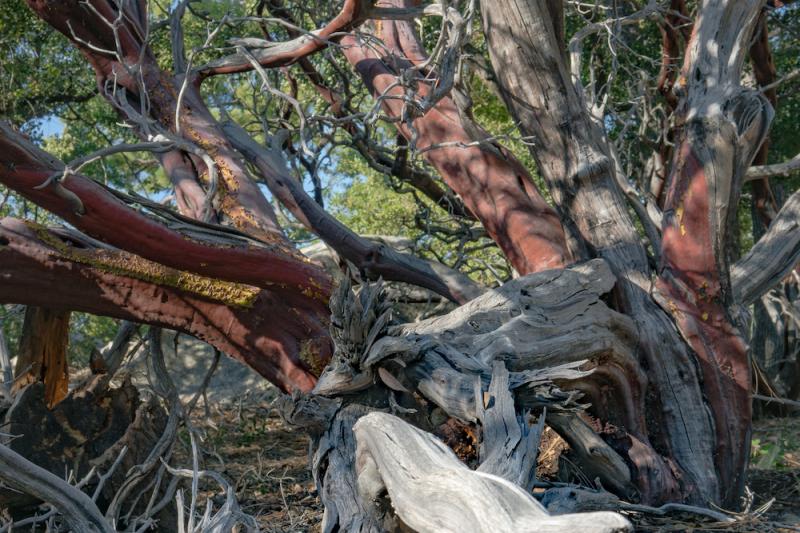
I’ve always been interested in medicinal plants that can be easily gathered but aren’t highly commercialized. You may be familiar with the commonly used herbal remedy uva ursi (Arctostaphylos uva ursi). However, uva ursi is just one of sixteen species of Arcotostaphylos listed in my Native American Ethnobotany book, all of which were used for food, medicine, and utilitarian purposes. Also known as manzanita, these various species from the Artostaphylos genus are of particular interest to me because I've encountered them in the wild.
Manzanita Uses
 All of the manzanitas, including uva ursi, are powerful astringents. The leaves can be used for any purpose where an astringent can be helpful, such as treating cuts, wounds, bruises, and other injuries. Strong astringents like manzanita and uva ursi are also valuable treatments for insect bites. Crush the fresh leaves to make a quick poultice.
All of the manzanitas, including uva ursi, are powerful astringents. The leaves can be used for any purpose where an astringent can be helpful, such as treating cuts, wounds, bruises, and other injuries. Strong astringents like manzanita and uva ursi are also valuable treatments for insect bites. Crush the fresh leaves to make a quick poultice.
One of the most common uses for manzanita in the literature is as a treatment for poison ivy or poison oak. A decoction, made from the leaves, is used as a wash, compress, or fomentation over the afflicted areas. A decoction can also be drunk to treat watery diarrhea.
Edible Berries and Flowers
The Arcotostaphylos genus is in the same family as blueberries and cranberries and the fruits are edible. Bears enjoy eating them, which is why another name for uva ursi is bearberry. Manzanita also means “little apple” in Spanish, because the unripe berries look like small Granny Smith apples and have a similar tart flavor.
Native Americans used them for beverages and other food purposes. The unripe berries sometimes have too much tannin to be palatable, so you need to taste them so you don't pick them too early. I found a great article explaining various ways to use them called How to Eat Manzanita Berries by Hank Shaw. He also explains that the flowers are edible.
Urinary Tract Infections
 Uva ursi is one of my favorite remedies for urinary tract infections. This is due to a substance called arbutin. When ingested, it is transformed into a compound called hydroquinone as it passes through the kidneys. Hydroquinone is a powerful disinfectant. It works best when the urine is alkaline, which is in contrast to cranberry juice, which works better with acid urine.
Uva ursi is one of my favorite remedies for urinary tract infections. This is due to a substance called arbutin. When ingested, it is transformed into a compound called hydroquinone as it passes through the kidneys. Hydroquinone is a powerful disinfectant. It works best when the urine is alkaline, which is in contrast to cranberry juice, which works better with acid urine.
The presence of arbutin is not confined to uva ursi, however, various species of manzanitas also contain arbutin, as does pipsissewa, another member of the same family. So, it is likely you could harvest the leaves of various species and also use them for urinary tract infections.
I’ve personally found uva ursi a very dependable remedy for UTIs, but I think it works best as a tea. If you make an infusion you get less tannin, so it’s not so astringent, but you do get the arbutin. I have used the tincture, too, both for UTIs and also for urinary incontinence, because the tannins do help to tone the bladder sphincter.
Uva ursi is an irritating diuretic and should be avoided when there is acute kidney inflammation. If in doubt, it may be wise to combine it with soothing, non-irritating diuretics like horsetail, cornsilk, and marshmallow.
Other Uses
American colonists found that the Indians had independently discovered uva ursi and mixed its leaves with their sacred tobacco in order to create the smoking mixture they called kinnikinnik. Uva ursi has also been reported to be helpful in diabetes in a similar way to huckleberry leaves (also in this family).
Uva ursi can also help with some problems with the female reproductive system. Years ago, my mom told me that the doctor was recommending she have a hysterectomy. I had her drink just one cup of uva ursi tea per day and in one week her symptoms had subsided.
In researching for this article I found a lot of information about the value of arbutin in skin care. Apparently, arbutin inhibits melanin, the pigment that makes skin darker. It suppresses the activity of tyrosinase, an enzyme that plays a role in melanin production. This means it can help to reduce hyperpigmentation, dark spots, or discolored areas on the skin when applied topically. This makes me curious to experiment with using extracts of uva ursi or various manzanita species in natural skin care products.
Manzanita Flower Essences
 Years ago when I was living in Southern California I remember driving up into the mountains to visit Idyllwild, a community in the forest not far from Palm Springs. That’s where I first saw manzanita trees. I remember being struck by the reddish-brown bark and the fact that some of the branches only had bark on part of the branch, while grey, dead-looking wood was visible on other parts of the branch. I remember collecting a branch that was half grey and half red, looking half dead and half alive, because I thought it was so beautiful.
Years ago when I was living in Southern California I remember driving up into the mountains to visit Idyllwild, a community in the forest not far from Palm Springs. That’s where I first saw manzanita trees. I remember being struck by the reddish-brown bark and the fact that some of the branches only had bark on part of the branch, while grey, dead-looking wood was visible on other parts of the branch. I remember collecting a branch that was half grey and half red, looking half dead and half alive, because I thought it was so beautiful.
Years later, when I read about manzanita flower essence (derived from A. viscida) that image came back to me. The flower essence is used for people who have an aversion to the physical world. They may feel a strong sense of disgust for the body and its functions. This may result in severe ascetic regimes, harsh diets, rituals surrounding food, and tendencies towards bulimia and anorexia.
Because of this signature I observed in the manzanitas I saw, I think of the person who needs manzanita flower essence as half-dead and half alive. They are not fully present with their body and its need. They need to integrate their spiritual self with their body to become fully present in the world. I’ve used manzanita with shooting star for people who are not fully embodied because of birthing trauma and I've used it with mariposa lily for people who did not have a nurturing, bonded relationship with their mother. It can help them feel more comfortable and less rigid in their body.
Downloads
Steven's Articles
October
-

-
Understanding Caffeine & Cellular Adaptation
Preserving the power of caffeine's buzz and the…
September
-

-
Horseradish
A pungent spice for aiding protein metabolism…
-

-
Banaba or Crepe Myrtle
A beautiful tree from Southeast Asia whose leaves…
August
-

-
Monkeyflowers
Flower essences to help see ourselves more clearly…
-

-
Mariposa Lilies
Strengthening the bond between mother and child…
-

-
The Noble Bay Leaf
A common kitchen herb for aiding digestion and…
-

-
Epimedium: Horny Goat Weed
A circulatory stimulant and kidney yang tonic…
July
-

-
The Medicinal and Nutritional Benefits of Apricots
A nutritious fruit and valuable medicinal seed for coughs
-

-
Dogwoods
Asian dogwood is used to stop excessive discharge,…
June
-

-
Neem: The Village Pharmacy
A popular Ayurvedic remedy for dental and immune…
-

-
Spilanthes: The Toothache Plant
A traditional remedy for teeth and gums, as well…
-

-
Forsythia
An anti-inflammatory, fever-reducing, and infection fighting herb
May
-

-
Buckwheat (Kashi)
A delicious, high protein, gluten-free, gut-healthy food
-

-
Leaky Gut Syndrome
Plugging the leaks on the underlying cause of…
-

-
Storksbill
An edible, medicinal, weedy herb, helpful for…

